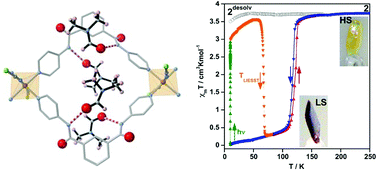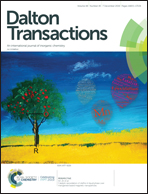A thermal- and light-induced switchable one-dimensional rare loop-like spin crossover coordination polymer†
Abstract
Rare loop-like isostructural one-dimensional coordination polymer (1D-CP) systems formulated as {Fe(DPIP)2(NCSe)2}n·4DMF (1) and {Fe(DPIP)2(NCSe)2}n·4DMF (2) were obtained by self-assembling FeII and pseudohalide NCX−(X = S, Se) ions in presence of the V-shaped bidentate bridging ligand, namely, N,N′-dipyridin-4-ylisophthalamide (DPIP), and were characterized by elemental analysis, IR spectroscopy, TGA, single crystal X-ray diffraction and powder X-ray diffraction. The magnetic studies show that complex 2 undergoes a complete thermally induced spin crossover (SCO) behavior centered at T1/2 = 120 K with ca. 5 K thermal hysteresis loop and light-induced excited spin state trapping effect (LIESST) with TLIESST = 65 K. However, either the homologous X = S (1) or the desolvated form of complex 2 is high spin at all temperatures, proving further the concerted synergy for the SCO of 2 between the intrinsic ligand field and that indirectly induced via hydrogen bond interaction. The current results provide valuable information for the design of new 1D SCO systems via the rational control of the cooperated effects derived from the intramolecular coordination bond and the intermolecular supramolecular interactions.



 Please wait while we load your content...
Please wait while we load your content...